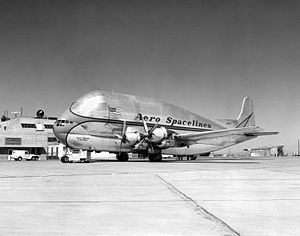Pregnant Guppy
| Pregnant Guppy | |
|---|---|
 |
|
| The Pregnant Guppy at the Dryden Flight Research Center for testing and evaluation (October 1962) | |
| Role | Outsize cargo freight aircraft |
| Manufacturer | Aero Spacelines |
| First flight | September 19, 1962 |
| Retired | 1979 |
| Status | Scrapped |
| Primary users |
Aero Spacelines NASA |
| Produced | 1 |
| Developed from | |
| Developed into | Aero Spacelines Super Guppy |
The Aero Spacelines Pregnant Guppy was a large, wide-bodied cargo aircraft built in the United States and used for ferrying outsized cargo items, most notably NASA's components of the Apollo program. The Pregnant Guppy was the first of the Guppy line of aircraft produced by Aero Spacelines. The design also inspired similar designs such as the jet-powered Airbus Beluga, and the Boeing Dreamlifter designed to deliver Boeing 787 parts.
In the late 1970s the Pregnant Guppy was advertised in government listing to make a bid to dispose and scrap. An ex Air Force pilot/private pilot and metallurgical engineer/entrepreneur by the name of Charles V. P. Balo won the government bid to scrap the plane. Ironic as it was years earlier when they were building the Guppy, Mr. Balo provided the aluminum for the manufacturing of the plane. Parts of the Guppy are still in use today. The landing gear, for instance and the landing gear motor was being used by a private citizen for an Off road vehicle.
In 1960, U.S. airlines were disposing of their obsolete piston-engined in favor of the newer jet-engined airliners. NASA was finding that barge transport of their increasingly large space program components from manufacturers on the West Coast to test and launch sites on the East Coast was slow and expensive. Aircraft broker Leo Mansdorf was stockpiling surplus Stratocruisers at Van Nuys prior to resale, and ex-USAF pilot John M. Conroy realized the potential of these aircraft to transport the large but relatively light rocket components.
Conroy presented his plans for an extensively modified Stratocruiser to NASA, where an official commented that the bloated aircraft resembled a pregnant guppy. Although NASA was lukewarm on the concept, Conroy mortgaged his house and founded Aero Spacelines International in order to build and operate the concept aircraft.
...
Wikipedia
